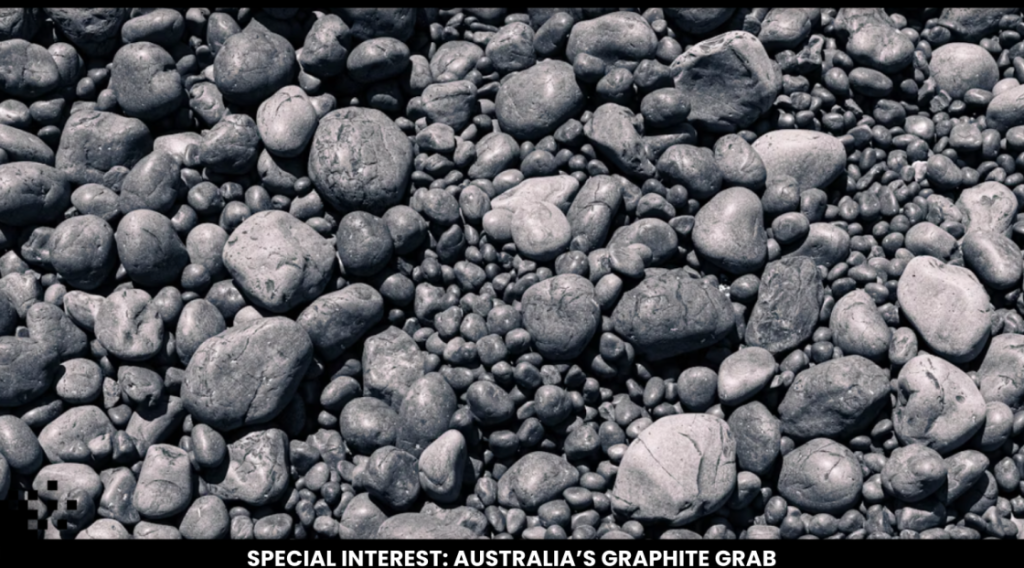Structural shift: Australia’s graphite grab – Special Feature

The first large graphite deposit was found in Borrowdale, UK in the 16th century. It was so pure and solid that people at the time initially thought it to be a form of lead, which in turn led to coining of the term “pencil lead”.
Graphite is not always mined like metals. The purest natural graphite called ‘lump graphite’ can literally be scooped out by hand in Sri Lanka, where it occurs in veins rather than ore deposits.
In the global push for decarbonisation and green technology, the crystalline allotrope of carbon is becoming a strategic material not just for EV batteries, but for nuclear fusion and hydrogen economies as well.
From Australia to Alaska, the prospecting for graphite in recent years has added more than 3.7 billion tonnes to the global resource base for the naturally occurring form of carbon. Part one of Mining.com.au‘s graphite series investigates the North American companies grappling for a share of the graphite market as China continues to dominate the global supply chain, from synthetic and natural graphite production to refining.
Part two uncovers the main graphite players in Australia seeking a share of the market. China dominates the market but not because of geology alone. While the country has abundant reserves, its dominance in graphite derives from various state subsidies, lower environmental restrictions, and greater refining capacity rather than raw geology.
As ex-China mine production comes online, natural graphite production is expected to grow 6% a year to reach 1.5 million tonnes by 2027. Australian mining companies are increasingly vying to contribute towards this supply.
Graphite is on the federal government’s critical minerals list. Although there are no large-scale producing graphite mines in the country, Australia hosts almost 8 million tonnes of economic demonstrated resources and 5 million tonnes of ore reserves. These reserves and resources are shared between three states – Queensland, South Australia, and Western Australia.
As reported in part one of this feature series, China by far remains the largest supplier of natural graphite globally, accounting for more than 70% of production. However, there are a growing number of graphite mines under development across not only Australia but in North America, Africa, Asia, and throughout Europe.
Globally, total contained graphite from identified resources exceeds 350 million tonnes – or 245 million tonnes of product covering all flake sizes – assuming a mining yield of 70%, as per the European Advanced Carbon and Graphite Materials Association (ECGA).
Benchmark Mineral Intelligence forecasts demand for natural graphite could surge 140% by 2030. This means circa 30 new natural graphite mines and 12 synthetic plants need to come online to fill the void.
Graphite is traditionally used in lubricants and steelmaking, but is becoming increasingly important due to its use in battery anodes. It can be mined (natural or flake graphite) or produced by boiling and subsequently calcining green petroleum coke (synthetic graphite).
Typically, natural graphite is less energy and emissions-intensive than synthetic graphite, due to the high temperatures needed for synthetic graphite production.


Australia grappling for graphite
Australian companies are making significant strides in graphite development, amid government support, and advanced processing capabilities. Some of the more active include Buxton Resources (ASX:BUX), EcoGraf (ASX:EGR), Syrah Resources (ASX:SYR), Talga (ASX:TLG), and Triton Minerals (ASX:TON).
International Graphite (ASX:IG6) is on track to be an Australian producer of industrial graphite products for traditional manufacturing and emerging battery markets. The company is advancing the Springdale-Collie graphite mine and integrated anode material manufacturing in Western Australia. It is using a $4.7 million grant to accelerate Feasibility Studies and establish a micronising facility.
In late July, International Graphite signed a cooperation agreement with Norwegian critical minerals investor and developer Arctic Graphite and Graphite Investment Partners to develop an expandable graphite processing facility in Germany.
Meanwhile, Kingsland Minerals (ASX:KNG) is working on potentially the largest graphite resource in Australia – the Leliyn deposit which is 700Mt to 1.11 billion tonnes @ 7.8 % TGC, with substantial upside potential through further drilling.


An emerging Australian exploration player is Lincoln Minerals (ASX:LML). It is advancing its flagship Kookaburra Graphite Project located 35km north of Port Lincoln, on South Australia’s Eyre Peninsula.
KGP has been assessed to contain measured, indicated, and inferred resources of 12.8Mt at 7.6% TGC. Material from Kookaburra in May attained battery-grade graphite purity levels (greater or equal to 99.95% TGC) across multiple test runs at two independent laboratories in Australia.
Speaking to Mining.com.au, Lincoln’s CEO Jonathon Trewartha says the global graphite market is undergoing a structural shift as demand for battery-grade graphite accelerates due to growth in the EV and renewable energy sectors.
“This is especially true for natural flake graphite, which is a critical component in lithium-ion battery anodes. At the same time, geopolitical dynamics such as China’s recent export restrictions on graphite have intensified the need for secure, ex-China supply chains,” the CEO says.
“Lincoln Minerals is in a strong position to contribute to this demand through its 100% owned Kookaburra Graphite Project (KGP) on South Australia’s Eyre Peninsula. KGP is one of the highest-grade undeveloped graphite projects in Australia, with a measured, indicated, and inferred mineral resource of 12.8Mt at 7.6% total graphitic carbon.
“At the same time, geopolitical dynamics such as China’s recent export restrictions on graphite have intensified the need for secure, ex-China supply chains”
“Importantly, recent independent test work has confirmed that graphite concentrate from KGP can be upgraded to battery-grade purity (≥99.95% TGC), a critical benchmark for downstream lithium-ion battery applications. This makes KGP one of a very small number of Australian projects capable of supplying premium-grade graphite into a growing anode material market.”
Lincoln also has a vertically integrated strategy, which includes downstream value-add studies into Battery Anode Material (BAM) production, positioning it competitively among Australian peers, especially given the project’s strong environmental credentials, infrastructure access, and strategic location near Port Lincoln.
The company is seeking to complete a BAM Scoping Study to assess the potential for downstream graphite processing, including purification and shaping technologies to produce coated spherical graphite for lithium-ion battery anodes.
It is advancing BAM downstream scoping work to validate processing flowsheets and value-add potential, while supporting future funding and offtake negotiations. The company will then finalise an updated Feasibility Study for stage one by FY27, incorporating updated costs, logistics, mine plan, and metallurgy.
Lincoln’s strategy also focuses on supplying battery anode manufacturers, automotive OEMs, and downstream graphite processors particularly those seeking to diversify away from China and secure stable, traceable, high-grade graphite supply from tier-one jurisdictions like Australia.
Engagement is ongoing with potential offtake and strategic partners as part of the company’s broader commercialisation plan.


Aspiring Australian companies
Near to Lincoln Minerals, Renascor (ASX:RNU) is advancing the Siviour Graphite Deposit, 120km northeast of Port Lincoln and 150km southwest of Whyalla on the Eyre Peninsula in South Australia.
Renascor is funded to advance the project, with $105 million cash at hand as of 30 June 2025 and a conditionally approved $185 million loan facility from the Australian Government’s $4 billion Critical Minerals Facility.
Renascor is also developing a vertically integrated BAM operation, comprising an upstream graphite mining and processing operation. It comprises a downstream BAM facility where graphite concentrate will be converted into PSG before being exported to lithium-ion battery anode manufacturers.
Renascor has provisional development authorisation for its downstream facility. The demonstration facility will convert graphite concentrate from the Siviour deposit into PSG through a continuous production process, enabling it to test, demonstrate, and optimise Renascor’s purification process.
Design, site preparation, procurement, and equipment testing is now complete at the PSG demonstration facility.
Much like Lincoln Minerals, Renascor considers its purification process to offer potential advantages over conventional purification methods used for PSG by also avoiding the use of hydrofluoric acid.
Learnings from the demonstration facility will be utilised in the detailed design stage and carried through into the construction and operation of the full-scale commercial PSG facility.
Renascor’s Managing Director David Christensen says the facility will allow the company to showcase and optimise its HF-free purification process and deliver a globally competitive Australian alternative to China’s current monopoly on PSG production.
“As the project moves into the construction phase this quarter, we are positioning Renascor to deliver value-added processing in South Australia and secure a role as a strategic supplier of high-purity battery anode material to international markets,” Christensen says.
Another graphite player in South Australia is Quantum Graphite (ASX:QGL), which is advancing the Uley 2 flake graphite project, including the past-producing Uley mine and the Mikkira deposit. The project is fully permitted and development ready, with a binding offtake agreement in place with a European trading group for 50% of its production for a minimum of five years.
Through its Sunlands Power joint venture with Sunlands Energy Co, Quantum is seeking to manufacture coarse-natural-flake-based thermal storage media sourced from Uley to be fitted within Sunland Energy’s TES Graphite Cell technology for grid-connected, long-duration energy storage.
In March 2025, the Australian Government granted Uley 2 and Sunland’s associated facilities major project status.
Meanwhile, Green Critical Minerals (ASX:GCM) owns the McIntosh Graphite Project in Western Australia, which is touted as one of the country’s largest graphite resources, estimated at more than 30 million tonnes.
A recently commissioned production plant is now operational, with manufacturing of very high density (VHD) graphite blocks up to 60x100x60mm, with manufacturing of blocks up to 160mm in thickness, and 200mm in length underway.
Discussions are underway for Green Critical to establish university and industry linkage partnerships aimed at demonstrating the superior thermal performance of VHD products in high-demand applications.
“Importantly, we’re not creating a solution for a future market, we’re delivering high-performance thermal products into an existing, high-demand sector that is actively searching for better, more cost-effective materials”
The company’s multi-channel distribution strategy, which includes partnerships with online retailers, means it is not waiting for major orders to begin selling, and can expedite access to a global market fast.
At the same time, collaborations with data centre providers like GreenSquareDC and its Korean market entry are positioning Green Critical for large-scale opportunities in the near future. The company is preparing its supply chain accordingly.
Managing Director Clinton Booth says with the VHD production plant now operational, Green Critical Minerals is shifting from initial rollout into active commercial execution, focused on fulfilling demand, scaling output, and maintaining product quality at volume.
“We’ve made key operational optimisations to ensure our processes are efficient, scalable, and capable of consistently delivering high-quality product. We’re building inventory in preparation of customer orders and significant demand increase,” says Booth.
“Importantly, we’re not creating a solution for a future market, we’re delivering high-performance thermal products into an existing, high-demand sector that is actively searching for better, more cost-effective materials. What sets us apart is our ability to move now.”
Critical shortage
Lincoln Minerals is confident that much like Green Critical, it will be a global graphite player as well. Trewartha says the inclusion of its Kookaburra project in the Australian Critical Minerals Prospectus reflects the urgency for such mines to come online, reinforcing Benchmark Mineral Intelligence forecast that 30 new natural graphite mines will need to come online globally in the next five years.
“The IEA and Benchmark have made it clear: the world will need dozens of new graphite mines to meet battery demand by 2030,” Lincoln’s CEO tells this news service.
“Natural graphite is essential for the production of lithium-ion battery anodes, and global supply chains are increasingly exposed to concentration risk especially given China’s dominance in both raw and processed graphite.
“In this context, projects like our KGP project are not just important, they’re essential.
“KGP is one of the highest-grade undeveloped graphite projects in Australia, located in a low-risk jurisdiction with excellent infrastructure, port access, and a favourable ESG profile. The project has already demonstrated the ability to produce battery-grade graphite (≥99.95% TGC) at lab scale, across multiple independent laboratories.”
Without new ex-China graphite production, particularly from jurisdictions like Australia, Trewartha says global EV and battery supply chains will struggle to meet energy transition goals.


Clean and green
The global battery and critical minerals industries are increasingly focused on clean and responsible processing. Lincoln’s hydrofluoric acid-free (HF) approach aligns strongly with these evolving expectations and positions the company as a forward-thinking supplier of low-impact anode material.
Hydrofluoric acid is one of the most hazardous chemicals in graphite processing, creating risks for people, communities, and the environment. By going HF-free, Lincoln is eliminating these hazards, avoiding toxic waste streams, while strengthening its social license to operate.
“Equally, downstream customers are demanding cleaner, safer supply chains. HF-free anode material not only meets these expectations but also differentiates Lincoln commercially, positioning the company as a sustainable and competitive supplier,” Trewartha adds.
As a forward-thinking supplier of low-impact anode material, Lincoln’s CEO outlines several major themes that will drive both Lincoln’s growth and the broader natural graphite market over the next five years.
“The exponential growth of the EV industry, battery gigafactories and data centres, especially in North America, Europe, and Asia will continue to drive graphite demand”
Global demand for natural graphite is forecast to increase by over 140% by 2030, driven primarily by lithium-ion battery anode requirements. Lincoln is well positioned to be a key contributor, he says.
“The exponential growth of the EV industry, battery gigafactories and data centres, especially in North America, Europe, and Asia will continue to drive graphite demand. Lincoln’s high-grade project and battery-grade purity results align directly with this need,” the CEO continues.
“As geopolitical tensions rise, global battery supply chains are shifting away from reliance on Chinese graphite. Lincoln’s tier-one jurisdiction in South Australia offers an attractive solution for customers seeking secure, ethical sourcing.
“Lincoln’s strategy to pursue coated spherical purified graphite production means it’s targeting not just the raw flake market but also the higher-margin, value-added BAM segment, opening up broader commercial opportunities.”
Write to Adam Orlando at Mining.com.au
Images: Green Critical, IMO, Lincoln & Mining.com.au

